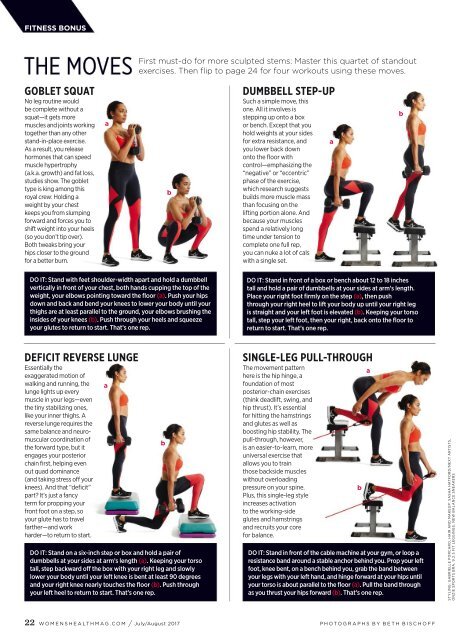Create successful ePaper yourself
Turn your PDF publications into a flip-book with our unique Google optimized e-Paper software.
FITNESS BONUS<br />
THE MOVES<br />
GOBLET SQUAT<br />
No leg routine would<br />
be complete without a<br />
squat—it gets more<br />
muscles and joints working<br />
together than any other<br />
stand-in-place exercise.<br />
As a result, you release<br />
hormones that can speed<br />
muscle hypertrophy<br />
(a.k.a. growth) and fat loss,<br />
studies show. The goblet<br />
type is king among this<br />
royal crew: Holding a<br />
weight by your chest<br />
keeps you from slumping<br />
forward and forces you to<br />
shift weight into your heels<br />
(so you don’t tip over).<br />
Both tweaks bring your<br />
hips closer to the ground<br />
for a better burn.<br />
a<br />
First must-do for more sculpted stems: Master this quartet of standout<br />
exercises. Then flip to page 24 for four workouts using these moves.<br />
b<br />
DUMBBELL STEP-UP<br />
Such a simple move, this<br />
one. All it involves is<br />
stepping up onto a box<br />
or bench. Except that you<br />
hold weights at your sides<br />
for extra resistance, and<br />
you lower back down<br />
onto the floor with<br />
control—emphasizing the<br />
“negative” or “eccentric”<br />
phase of the exercise,<br />
which research suggests<br />
builds more muscle mass<br />
than focusing on the<br />
lifting portion alone. And<br />
because your muscles<br />
spend a relatively long<br />
time under tension to<br />
complete one full rep,<br />
you can nuke a lot of cals<br />
with a single set.<br />
a<br />
b<br />
DO IT: Stand with feet shoulder-width apart and hold a dumbbell<br />
vertically in front of your chest, both hands cupping the top of the<br />
weight, your elbows pointing toward the floor (a). Push your hips<br />
down and back and bend your knees to lower your body until your<br />
thighs are at least parallel to the ground, your elbows brushing the<br />
insides of your knees (b). Push through your heels and squeeze<br />
your glutes to return to start. That’s one rep.<br />
DO IT: Stand in front of a box or bench about 12 to 18 inches<br />
tall and hold a pair of dumbbells at your sides at arm’s length.<br />
Place your right foot firmly on the step (a), then push<br />
through your right heel to lift your body up until your right leg<br />
is straight and your left foot is elevated (b). Keeping your torso<br />
tall, step your left foot, then your right, back onto the floor to<br />
return to start. That’s one rep.<br />
DEFICIT REVERSE LUNGE<br />
Essentially the<br />
exaggerated motion of<br />
walking and running, the<br />
lunge lights up every<br />
muscle in your legs—even<br />
the tiny stabilizing ones,<br />
like your inner thighs. A<br />
reverse lunge requires the<br />
same balance and neuromuscular<br />
coordination of<br />
the forward type, but it<br />
engages your posterior<br />
chain first, helping even<br />
out quad dominance<br />
(and taking stress off your<br />
knees). And that “deficit”<br />
part? It’s just a fancy<br />
term for propping your<br />
front foot on a step, so<br />
your glute has to travel<br />
farther—and work<br />
harder—to return to start.<br />
a<br />
DO IT: Stand on a six-inch step or box and hold a pair of<br />
dumbbells at your sides at arm’s length (a). Keeping your torso<br />
tall, step backward off the box with your right leg and slowly<br />
lower your body until your left knee is bent at least 90 degrees<br />
and your right knee nearly touches the floor (b). Push through<br />
your left heel to return to start. That’s one rep.<br />
b<br />
SINGLE-LEG PULL-THROUGH<br />
The movement pattern<br />
here is the hip hinge, a<br />
foundation of most<br />
posterior-chain exercises<br />
(think deadlift, swing, and<br />
hip thrust). It’s essential<br />
for hitting the hamstrings<br />
and glutes as well as<br />
boosting hip stability. The<br />
pull-through, however,<br />
is an easier-to-learn, more<br />
universal exercise that<br />
allows you to train<br />
those backside muscles<br />
without overloading<br />
pressure on your spine.<br />
Plus, this single-leg style<br />
increases activation<br />
to the working-side<br />
glutes and hamstrings<br />
and recruits your core<br />
for balance.<br />
DO IT: Stand in front of the cable machine at your gym, or loop a<br />
resistance band around a stable anchor behind you. Prop your left<br />
foot, knee bent, on a bench behind you, grab the band between<br />
your legs with your left hand, and hinge forward at your hips until<br />
your torso is about parallel to the floor (a). Pull the band through<br />
as you thrust your hips forward (b). That’s one rep.<br />
b<br />
a<br />
STYLING: GABRIELLE PORCARO, HAIR AND MAKEUP: SASHA HATFORD/NEXT ARTISTS,<br />
ONZIE SPORTS BRA, 9.2.5 FIT LEGGINGS, NEW BALANCE SNEAKERS<br />
22 WOMENSHEALTHMAG.COM / July/August <strong>2017</strong><br />
PHOTOGRAPHS BY BETH BISCHOFF

















